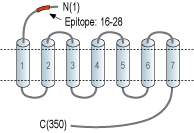Overview
- Peptide (C)DKDTLDLNTPVDK, corresponding to amino acid residues 16-28 of human C5a anaphylatoxin receptor (Accession P21730). Extracellular, N-terminus.

 Western blot analysis of Human K562 myelogenous leukemia (lanes 1 and 4), MEG-01 chronic myelogenous leukemia cell (lanes 2 and 5), and THP-1 acute monocytic leukemia (lanes 3 and 6) cell lysates:1-3. Anti-Human C5aR1 (extracellular) Antibody (#AAR-032), (1:200).
Western blot analysis of Human K562 myelogenous leukemia (lanes 1 and 4), MEG-01 chronic myelogenous leukemia cell (lanes 2 and 5), and THP-1 acute monocytic leukemia (lanes 3 and 6) cell lysates:1-3. Anti-Human C5aR1 (extracellular) Antibody (#AAR-032), (1:200).
4-6. Anti-Human C5aR1 (extracellular) Antibody, preincubated with Human C5aR1 (extracellular) Blocking Peptide (#BLP-AR032).
 Cell surface detection of C5aR1 by indirect flow cytometry in live intact human THP-1 monocytic leukemia cells:___ Cells.
Cell surface detection of C5aR1 by indirect flow cytometry in live intact human THP-1 monocytic leukemia cells:___ Cells.
___ Cells + goat-anti-rabbit-FITC.
___ Cells +Anti-Human C5aR1 (extracellular) Antibody (#AAR-032), (2.5μg) + goat-anti-rabbit-FITC..- The blocking peptide is not suitable for this application.
- Haas, P.J. and van Srijp, J. (2007) Immun. Res. 37, 161.
- Marder, S.R. et al. (1985) J. Immunol. 134, 3325.
- Guo, R.F. and Ward, P.A. (2005) Annu. Rev. Immunol. 23, 821.
- Schumacher, W.A. et al. (1991) Agents Actions 34, 345.
- Laudes, I.J. et al. (2002) Am. J. Pathol. 160, 1867.
- Geva, A. et al. (2000) J. Biol. Chem. 275, 35393.
- Klco, J.M. et al. (2003) J. Biol. Chem. 278, 35345.
- Monk, P.N. et al. (2007) Br. J. Pharmacol. 152, 429.
- Huttenrauch, F. et al. (2005) J. Biol. Chem. 280, 37503.
- Ward, P.A. (2009) J. Mol. Med. 87, 375.
- Gerard, N.P. et al. (1989) J. Biol. Chem. 264, 1760.
- Werfel, T. et al. (1992) Blood 79, 152.
The innate immune system identifies pathogens by recognizing known elements. This response ultimately leads to the production of proinflammatory substances and the activation of phagocytic neutrophils and macrophages1. Activation of the complement system is an important initial even in the response against pathogens. This system includes some thirty different proteins that act together to form a complex1.
C5a is one of the most potent inflammatory peptides generated by complement activation. This peptide has many functions such as acting as a chemoattractant for neutrophils2,3. C5a acts as a vasodilator3,4 and activates the coagulation pathway3,5 just to name a few.
C5a exerts its numerous actions by binding to C5aR and C5L2. C5aR belongs to the superfamily of G-protein coupled receptors (GPCRs). Like all members, C5aR has seven transmembrane domains, an extracellular N-terminus and an intracellular C-terminal tail. C5aR can form homodimers6-8 or heteromer with CCR5, chemokine receptor, for example8,9. Activation of C5aR by C5a binding causes Ca2+ mobilization10.
C5aR expression is detected in neutrophils, eisinophils, basophils and monocytes3,11,12. The receptor is also expressed in lung and liver13,14.
Blocking C5aR by peptides or organic small molecules is in the pipeline for treating chronic inflammatory disorders/diseases like arthritis, inflammatory bowel disease and lung/liver injuries8.
Application key:
Species reactivity key:
Anti-Human C5aR1 (extracellular) Antibody (#AAR-032) is a highly specific antibody directed against an epitope of human C5a anaphylatoxin receptor. The antibody can be used in western blot and indirect live cell flow cytometry applications. It has been designed to recognize C5aR from human samples only.
